Research Article :
Yellow, cyan, magenta and black inks were extracted from documents printed using two common brands of printing cartridge in Nigerian market and analyzed to identify / compare the functional groups present using Fourier Transform Infra-red Spectroscopy (FTIR). The FTIR spectra obtained were found to show highly characteristic absorption bands depending on the composition of the printer inks. Also, the results indicated the presence of triarylmethane dyes, epoxy resins, alkyd resin and esters in all the inks as they are peaks assigned to the vibration of aliphatic ester, asymmetrical and symmetrical stretching. The pure ink and its extract from the same band were also found to exhibit similar FTIR spectra while inks extract from different brands exhibits marked difference in absorption bands. This research can provide valuable information if an admitted sample is provided for comparing with the suspect printed document.
Examination
of inks on questioned documents has become common, and law enforcement
agencies using this technique during their criminal investigations.
Questioned documents can include diary entries, or whole diary, reconstructed
files and false dated correspondence, prepared to show a particular sequence of
events, occurred in the past or more simply a forged signature or an altered
cheque [1,2]. Subtle alteration to documents, such as papers involving medical malpractice, tax returns, will
scripts and insurance claims, divorce judgments, copyright certificates,
agreements related to labour management disputes; employee problem settlements
and a variety of contracts etc. can have significance financial implications.
These kinds of many cases have been submitted by a number of crime reporters or
document investigators. Incidents of forgery have increased tremendously and to
alter these documents printers, copiers (inkjet printer) are widely used. The
detection of alterations or additions to a document and an assessment of when
the document was written have become a prime concern of document examiners and
ink chemists [3,4]. Document examiners have invented methods which have been
successfully used for examining and identifying printing inks scientifically.
These techniques include paper chromatography, paper
electrophoresis, luminescence,
micro spectrometry, diffuse reflectance Fourier transform infrared,
luminescence photography, laser excitation and spectroscopy, thin-layer
chromatography, high-performance liquid chromatography, and capillary
electrophoresis [1-10]. There is little or no information regarding the
application of a sequence of selected standard techniques to the Nigerian
population of inks used in printing. Also, no report presenting result of
characterization/ comparison of inkjet printer inks collected from the market
in Nigeria. There is a need to make effort in filling the gap in current
analytical methodology of forensic questioned document examination in the
country. Characterization of writing/printing instruments used to produce the
document such as ink, paper etc. may be a leading step in the investigation of
forgery in Nigeria. The aim of this study therefore is to analyze, compare and contrast ink
extracted from printed documents using two brands of printing cartridge in the
Nigerian market. This will be achieved by subjecting the extracted inks to
Fourier Transform Infrared Spectroscopy (FTIR)
analysis. It is hoped that the results from this study will provide valuable
information / data if an admitted sample is provided for comparison with the
suspect printed document in Nigeria. Also, the proposed method in the study
could be used for examination of ink on documents taking extremely small
(negligible portion) of the sample from an unimportant area of the document with
the permission of the court. Materials All reagents used were
analytical grade reagents obtained Sigma Aldrich Company U.S.A. Double distilled
water was used throughout for the preparation of samples and dilution of the
stock standard solutions. The glass wares used in the study were decontaminated
by overnight soaking in 5 % HNO3. Sample collection The method used in sample
collection is that of Sharma et al. [11]. Five colored printouts each
containing of cyan, magenta, yellow and black color were printed from inkjet
printers of two leading ink printing manufacturers (Silver tosh and Hewlett
Packard) in Nigerian Market. White paper of A4 size was used to take all
samples. All four printed color i.e. cyan, magenta, yellow, and black from each
printout were extracted, analyzed and interpreted. The two leading
manufacturers were marked as A and B respectively and their different models
were marked as 1, 2, 3and so on. The samples were given marking as A1, A2, A3
,A4,A5,….A10 for different models of brand A and B1, B2,B3,B4…; for different
models of brand B. Separation of ink from
printed Document The ink from the printed
document was separated following the method of Sharma et al. [11]. A colored
squared block of constant area was taken from the sample document and cut into
small pieces. The pieces of paper were then transferred to 15 ml beaker and
titurated with 5 ml of methanol. The sample was then allowed to be extracted at
room temperature with intermittent shaking. The methanol extract was then
transferred to 10 ml volumetric flasks after filtering through a filter paper.
The extract was made up to 4 ml. The same procedure was followed for all
samples for cyan, magenta, yellow and black. In order to avoid any interference
and to record the response of matrix i.e. paper and the reagent i.e. methanol
towards IR, the blank samples of matrix and reagent were also prepared
following the same procedure. Preparing Pellet for
Scanning 2ml of methanolic solution was
taken in a china dish and evaporated at room temperature to dryness and heated
for about 10minutes in an oven. The residue was scratched from the walls of
china dish and mixed intimately with dry KBr. After this process pellets were
prepared by using a pellet maker. The same procedure was followed for all
samples of Cyan, Magenta, Yellow and Black Color. Scanning of Samples The FTIR analyses of the samples
were carried using a spectrometer from Agilent technology. The scanning was
done through a wave range of 3500 to 400 wave number cm-1 FTIR
study Figures 1-5
shows the FTIR spectra of pure and extracted inks of Brand A while the spectra
obtained for Brand B are presented in Figures 6,7. Peaks obtained from the
various spectra as well as assignments to the respective peaks are presented in
Tables 1-5. The results presented show the various % transmittances
corresponding to the respective wave length of
absorption. It should be noticed that most of the absorption bands in the inks
spectra are complex peaks, and exhibited band in different areas that are
common to many organic compounds typically used in ink formulation. For
instance Peaks in the range from 2000 to 1700 cm_1 were observed, which is the characteristic frequency of carbonyl (C=O)
stretching vibration indicating that aliphatic acids or their esters are
present in the ink colors studied [12]. There are
indications of the presence of triarylmethane dyes, epoxy resin, alkyd
resin, and solvents in the inks as there were peaks assigned to the vibration
of aromatic ether (Ar – O), asymmetrical and symmetrical stretch vibration of
aliphatic ether (C – O), asymmetrical and symmetrical stretch vibration of the
C – O –C bonds. The FTIR
spectra obtained were also found to show highly characteristic absorption bands
depending upon the compositions of the printer inks as it could be seen that
every printer ink batch exhibits characteristic IR spectra. Different brands of ink
cartridge also exhibited different characteristic IR spectra. Also, some common
ingredients in different brands gave similar FTIR spectral bands for those
components. It was also found that pure ink and its extract from the same brand
exhibited similar FTIR spectra. Figure 1: FTIR spectra of (A) pure (B) extracted magenta ink of Brand
A. For instance,
similar peaks for O‒H Stretch, C‒O asymmetric were stretching for the same
brand. However, ink extracts from different cartridges of different brands on
the same paper exhibit marked differences. The difference between various
samples of ink can be seen by observing at the intensity of main peak, the
pattern of each spectrum and the absence or presence of some characteristic
bands. Figure 2: FTIR spectra of (A) pure and (B) extracted cyan of Brand A. Figure 3: FTIR spectra of (A) pure and (B) extracted yellow ink of
Brand A. Figure 4: FTIR spectra of (A) pure and (B) extracted black ink of
Brand A. Figure 5: FTIR spectra of (A) methanol (B) methanol and paper
extract. Figure 6: FTIR spectra of extracted (A) black ink of brand B and (B)
magenta of Brand B. Figure 7: FTIR spectra of extracted (A) yellow ink of brand B and (B)
cyan of Brand B. For instance C‒H Opp (Aromatic)
peak which was observed at 762 in the yellow ink extracted of brand A was
absent in brand B, the ‒ C≡C‒ stretch peak at 2125 present in the black ink
extract of brand A was absent in brand B, the N‒H Wag at 996 in the extracted
cyan ink sample of brand A was absent in brand B Cyan ink sample, the ≡CH peak
at 1000 in the magenta ink sample extract of brand A was absent in brand B. According to Beer-Lambert law,
absorption is related to concentration (C in mole), path length (d in cm) and
molar absorptivity according to the following equation [13], If the incident radiation
entering the sample cell is given by I0 and the amount transmitted is It. The
transmittance of the solution is defined as the fraction of the incident
radiation that is transmitted and can be written as, On the other hand, percentage
transmittance is given in equation 3 while equation 4 gives From the logarithm of equation
4, equation 5 is obtained, The left hand side of equation 5
corresponds to absorbance (Ia). Therefore, the relationship between absorbance and
transmittance is given according to equation 6, Using
equation 6, values of absorbance were calculated and plotted with their
corresponding wave numbers. These are presented in Figures 8-15. In Figures
8-11, plots showing the variation of absorbance with wave number of FTIR absorption by pure and
extracted inks of Brand A are presented. Figures 12-15, show plots of the
variation of absorbance with wave number of FTIR absorption by inks extracted
from documents printed using the different studied brands (Brand A and B). From
the plot, it can be seen that two brands exhibited marked differences in their
absorbance. Figure 11: Variation of absorbance with wave number of FTIR
absorption by pure and extracted yellow ink of Brand A. Based on the
obtained results the following conclusion can be drawn. Fourier Transform Infrared Spectroscopy,
though strictly not nondestructive could be used for examination of inks on
documents taking extremely small (negligible portion) of the sample from an
unimportant area of the document with the permission of the court. Fourier
Transform Infrared Spectroscopy is a simple, direct and reproducible method of
comparing computer printing inks. Inks when extracted from printed documents
will exhibit similar absorption spectra while those from different brands will
give marked differences in their absorption bands. 1.
Tebbett I.
Forensic science application (1991) Forensic Science Review 3: 71-82. 2.
Harris J. A
Preliminary report on the nondestructive examination on question documents by
FTIR spectroscopy (1991) Canadian Society Forensic Sci J 24: 5-8. 3.
Egan JM, Hagan KA
and Brewer JD. Forensic analysis of black ballpoint pen inks using capillary
electrophoresis (2005) Forensic Science Communications 7: 21. 4.
Egan WS, Galipo
RC, Kochanowski BK, Morgan SL, Bartick EG, et al. Forensic discrimination of
photocopy and printer toners III. Multivariate statistics applied to scanning
electron microscopy and pyrolysis gas chromatography/mass spectrometry (2003)
Analytical Chemistry 376: 1286-1297. https://doi.org/10.1007/s00216-003-2099-3 5.
El-Din NMS, Sabaa
MW and Hamed HR. Influence of Three Chemical Erasures on Different Types of
Inks Marked on Several Document Papers: An Analysis of the Chemical Reactions
Occurring on Paper Between Different Liquid Erasures and Writing Inks (1998)
Int J Forensic Document Examiners 4: 9. 6.
Fabianska E and
Trcinska BM. Differentiation of ballpoint and liquid ink. A comparison of
method in use, problem of forensic science (2001) 46: 383-400. 7.
Fanali S
and Schudel M. Some separations of black and red water-soluble fiber-tip pen
inks by capillary zone electrophoresis and thin layer chromatography (1991) J forensic
science36: 1992-1997. http://dx.doi.org/10.1520/JFS13135J 8.Geiman I,
Marco-Leona BS and John LR. Application of Raman Spectroscopy and Surface
Enhanced Roman Scattering to the analysis of synthetic dyes found in ball point
pen inks (2009) J forensic science 54:
947-952.https://doi.org/10.1111/j.1556-4029.2009.01058.x 9.
Hofer R.
Dating of ballpoint pen inks (2004) J forensic science49: 1-5. https://doi.org/10.1016/j.microc.2017.05.014 10. Horton R and Nelson L. An evaluation of the use of
laser-inducer infra-red luminescence to differentiate writing inks (1991) J Forensic
Science 36: 838-843. https://doi.org/10.1520/JFS13093J 11. Sharma R, Gyal K, Chettree A, Baggi TR and Gupta AK.
Comparative analysis of inkjet printer inks extracted from printed documents by
FTIR spectrophotometry (2013) IOSR J Applied Chemistry5: 36-41. http://dx.doi.org/10.9790/5736-0533641 12. Ameh PO. A comparative study of the inhibitory effect
of gum exudates from khaya senegalensis
and albizia ferruginea on the
corrosion of mild medium (2015) Int J metals1-3. http://dx.doi.org/10.1155/2015/824873 13.
Eddy NO, Ameh PO
and Ibrahim A. Physicochemical characterization and corrosion inhibition
potential of ficum benjamina (FB) gum for aluminum in 0.1 M HCL (2015) Walailak
J sci and technol 12: 1121-1136. http://dx.doi.org/10.14456/wjst.2015.94 Paul Ocheje Ameh, Department of Chemistry and
Forensic Sciences, Nigeria Police Academy, Wudil, Kano, Nigeria Email: nocaseoche@yahoo.com Ameh PO and Ozovehe MS. Forensic Examination of Inks Extracted from
Printed Documents Using Fourier Transform Infrared Spectroscopy (2018) Edelweiss Appli Sci Tech 1: 10-17 Forensic science, ink analysis, Document examination, FTIR
Forensic Examination of Inks Extracted from Printed Documents Using Fourier Transform Infrared Spectroscopy
Paul Ocheje Ameh and Musa Suud Ozovehe
Abstract
Full-Text
Introduction
Materials and Method
Results and Discussions
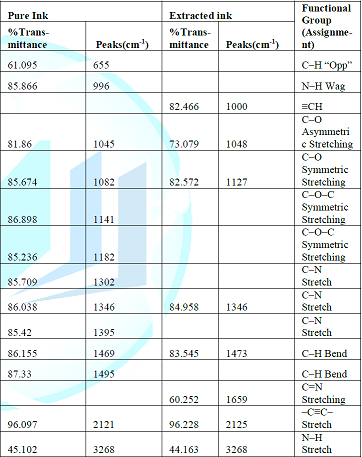
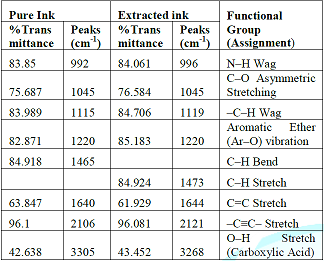
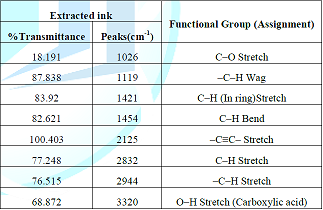
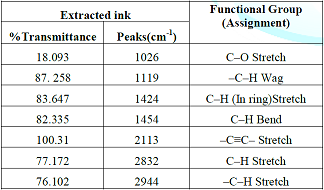
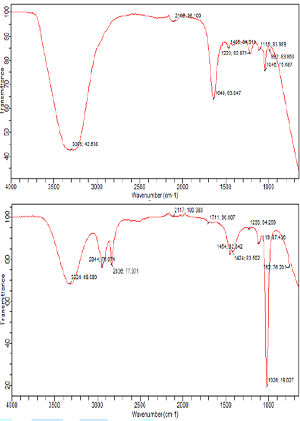
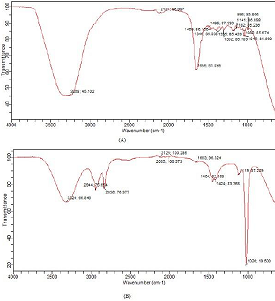
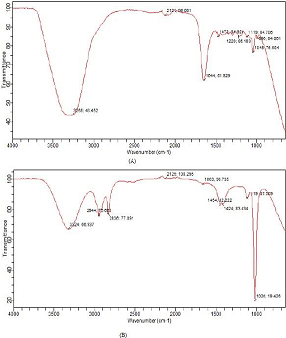
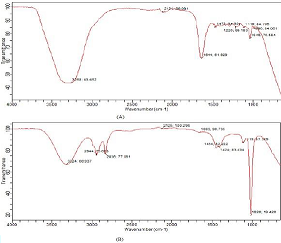
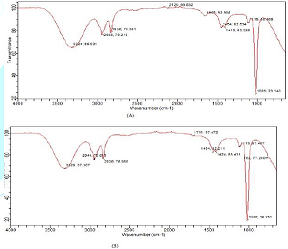
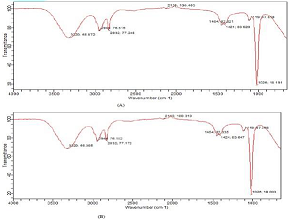
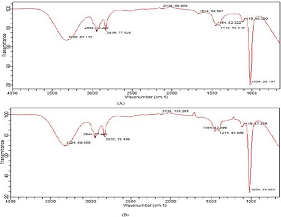
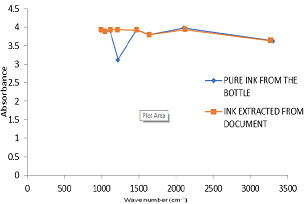
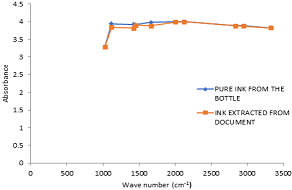
From the
plot, it can be seen that both pure and extracted inks of the same brand
exhibited maximum absorption at the same wave number and also show similarity
or closeness to similarity in each other wave number. This
shows that the extracted ink has some compatibility factors with the pure ink
of brand A.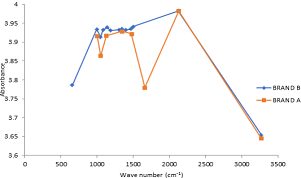
Conclusion
References
*Corresponding author:
Citation:
Keywords